When it comes to wheelchair ramp installation, the choice between DIY and professional services can be pivotal. While the idea of building your own ramp might seem appealing, the complexities involved in ensuring safety, durability, and ADA compliance often make professional installation the wiser choice. Let's explore both options to help you make an informed decision that guarantees accessibility without compromising on quality or safety.
The Evolution of Wheelchair Ramp Installation
Traditional DIY Approach
- Basic wood constructions
- Limited knowledge of ADA guidelines
- Often non-compliant with local building codes
- Prone to safety hazards
- Shorter lifespan due to improper materials
Modern Professional Installations
- Advanced materials (aluminum, composite)
- Strict adherence to ADA standards
- Compliance with all local regulations
- Enhanced safety features
- Longer-lasting, low-maintenance solutions
Key Considerations for Wheelchair Ramp Installation
Critical Factors to Consider
- ADA compliance and local building codes
- Proper slope and length calculations
- Material selection for durability and safety
- Adequate support structures and weight capacity
- Weather resistance and maintenance requirements
- Installation time and complexity
- Long-term cost-effectiveness
Professional Wheelchair Ramp Solutions

GATEWAY 3G Solid Surface Ramp
The GATEWAY 3G Solid Surface Ramp offers a professional-grade solution that ensures safety, durability, and ADA compliance.
- Seamless transition from ground to doorway
- Slip-resistant surface for all-weather safety
- Modular design for custom configurations
- Professional installation available for perfect fit

PATHWAY 3G Modular Access System
The PATHWAY 3G Modular Access System exemplifies the benefits of professional design and installation for complex accessibility needs.
- Versatile modular system for various layouts
- ADA compliant with proper professional setup
- Durable aluminum construction for longevity
- Expert installation ensures optimal safety and functionality
Wheelchair Ramp Installation in Various Settings
Residential Applications
For home installations, the complexity of the project often surprises DIY enthusiasts. The Johnson family in Ohio initially considered building their own ramp but opted for professional installation of a SUITCASE Singlefold Ramp. This decision ensured proper slope calculations and secure anchoring, providing safe access to their split-level home entrance.
Commercial Environments
In business settings, ADA compliance is non-negotiable. A local pharmacy chain faced potential legal issues with their DIY ramps until they invested in professional installation of the GATEWAY 3G Solid Surface Ramp system. This upgrade not only brought them into compliance but also significantly improved customer access and safety.
Public Spaces and Events
Temporary installations for events require expertise to ensure safety and accessibility. An outdoor art festival organizer learned this lesson after DIY ramps failed to meet safety standards. Switching to professionally installed SUITCASE Trifold AS Ramps resolved their accessibility challenges and enhanced the event's inclusivity.
Challenges and Solutions in Wheelchair Ramp Installation
Challenge: Complex ADA Regulations
DIY installations often fail to meet detailed ADA requirements.
Solution: Professional Expertise
Certified installers ensure full compliance with all regulations.
Challenge: Structural Integrity
Improper DIY construction can lead to safety hazards.
Solution: Engineered Designs
Professional solutions offer tested, structurally sound installations.
Choosing Between DIY and Professional Installation
Key Factors to Consider
Maintenance Tips for Wheelchair Ramps
- Regularly inspect the ramp for any signs of wear or damage.
- Keep the ramp surface clean and free of debris to maintain traction.
- Check and tighten any loose bolts or fasteners periodically.
- Apply anti-slip coating annually, especially for wooden ramps.
- Clear snow and ice promptly in winter to prevent accidents.
- Trim any nearby vegetation to prevent encroachment on the ramp.
- For wooden ramps, re-seal or repaint every 2-3 years to protect from weather damage.
For more detailed maintenance advice, especially for professionally installed ramps, check out our guide on Mastering Wheelchair Ramp Care.
The Value of Professional Wheelchair Ramp Installation
While the allure of DIY projects is understandable, the installation of a wheelchair ramp is a task where professional expertise truly shines. The complexities involved in ensuring ADA compliance, structural integrity, and long-term safety often surpass the capabilities of most DIY enthusiasts.
Professional installation not only guarantees compliance with all relevant regulations but also provides peace of mind. It ensures that the ramp will be safe, durable, and perfectly suited to the specific needs of its users. The initial investment in professional services often results in long-term savings, both in terms of maintenance and potential liability.
Moreover, professional installers bring a wealth of experience in dealing with various architectural challenges and can offer customized solutions that may not be apparent to the average homeowner. This expertise is invaluable in creating an accessibility solution that seamlessly integrates with your property while maximizing safety and functionality.
For more insights on the benefits of professional ramp solutions, explore our article on Unlocking Accessibility: The Ultimate Guide to Wheelchair Ramps.
Expert Wheelchair Ramp Installation at Your Service
Ready to ensure safe, compliant, and professionally installed wheelchair access? Don't compromise on quality and safety. Get a free quote for professional installation tailored to your specific needs.
Get a Free Quote








